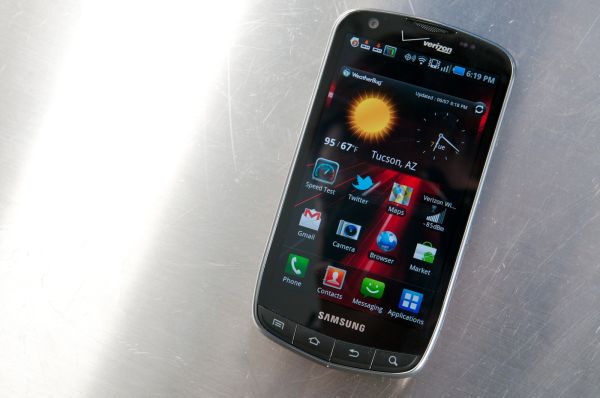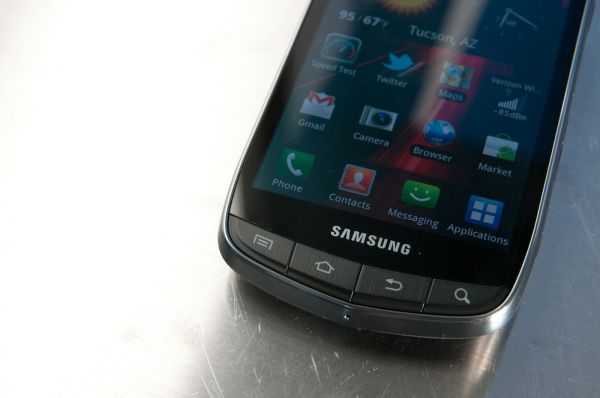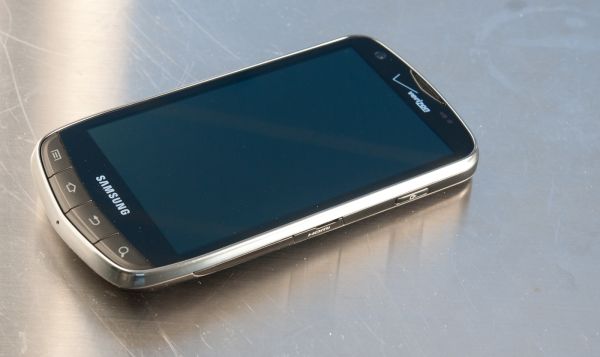Samsung Droid Charge Review - Droid Goes LTE
by Brian Klug on June 22, 2011 7:47 AM EST- Posted in
- Smartphones
- Samsung
- LTE
- 4G
- Droid Charge
- Mobile
Samsung is doing something interesting lately. Instead of outright releasing Galaxy S 2 in the US, each carrier is getting a mid-cycle refresh of the Galaxy S with 4G compatibility and more recently Super AMOLED Plus. T-Mobile was first with the Samsung Galaxy S 4G, then came the Droid Charge on Verizon which we’re looking at now, and finally AT&T got the Samsung Infuse 4G. The latter two have Super AMOLED Plus displays and different basebands. Right now we’re looking at Verizon’s second 4G LTE device, and the first to earn the ‘Droid’ level branding - the Samsung Droid Charge.
The Droid Charge (henceforth just Charge) is an interesting mid-cycle refresh of the Samsung Fascinate (which we reviewed back when it came out), retaining much of the handset’s core features. Notably, both run Android 2.2 and are based around a 1 GHz Samsung Hummingbird SoC with SGX 540 graphics. Where the two differ is the inclusion of 512 MB of LPDDR2, a 4G LTE baseband, front facing 1.3 MP camera, and 4.3” WVGA Super AMOLED display. There are other differences such as more storage both internal and external, but the primary difference is inclusion of 4G LTE and that huge display.
The Charge’s industrial design is a bit unique, resembling something of a cross between the iconic B-2 Spirit stealth bomber and a Nexus S. I’m not sure I’m a huge fan of yet another design that clearly is inspired by radar-deflecting angles and the homogenous grey color of iron-ball paint radar-absorptive material. It’s just a totally tired design direction. The device is ringed with chrome (a common Galaxy S motif) and is slightly angled up in the front.
There’s an angular point in the front middle where the microphone port is, and below it a small space to shove a thumbnail into and remove the battery cover.
This angular motif is continued everywhere on the Charge - the earpiece grille up at the top matches it with a similarly shaped triangle, and on the back the chrome ringing the camera and flash also has an angled style. It all kind of comes off in a way that makes the Charge feel masculine, but at the same time carries a bit of prepubescent opulence.
The Charge reminds me a lot of the Nexus S because of its bulge on the bottom. The phone doesn’t lay completely flat, instead it rests on three points formed by the upper back and the center of the backside bulge. The speaker slot is located on the side of the bulge and as a result isn’t muffled when the phone is placed face up on a table for speakerphone or conference calls.
One of the things I haven’t seen for a while (outside of the Droid X and X2) are physical android buttons. The Charge’s four buttons are both adequately clicky and backlit evenly. The four buttons are actually two groups of two, with with the leftmost two and rightmost two buttons each being discrete buttons. You can sort of tell that they’re the same piece, because clicking one moves the other button, but so far I haven’t experienced any errant clicks.
It’s a bit weird using something with physical buttons after months using phones with capacitive – more than once I found myself lightly pressing on the region and then waiting, puzzled why nothing happened. In addition, pressing any of the four Android buttons while the device is off does not turn the handset on, so you can put your fears that hardware buttons will lead to errant in-pocket power-ons to bed. Only the power button does that duty.





















61 Comments
View All Comments
tuhinz - Wednesday, June 22, 2011 - link
The screenshots for the old and new builds are mixed up.Brian Klug - Wednesday, June 22, 2011 - link
I'm going to clean things up, but I ended up taking a bunch of screenshots before the update, and then after, and figured I'd just show everything.-Brian
Brian Klug - Wednesday, June 22, 2011 - link
Oops I see what you mean now - D'oh, fixed.-Brian
shaolin95 - Wednesday, June 22, 2011 - link
You should be adding a comment about vsync and benchmarks like Neocore. Most phones will be fps capped like the Galaxy S ones to 55fps or so.Regards
tayb - Wednesday, June 22, 2011 - link
Come on. This is just getting absolutely ridiculous. Android 2.3 has been out since DECEMBER. That's 7 months ago. Why are we still getting phones with an OS that was replaced more than half a year ago.dagamer34 - Wednesday, June 22, 2011 - link
To wrap this review up, if you want decent LTE battery life on your handset, wait for integrated GSM/CDMA/LTE chipsets.vision33r - Wednesday, June 22, 2011 - link
Impatient Android users would never wait since they change phones every 6 months.PeteH - Wednesday, June 22, 2011 - link
Do we know the timeframe on low-power integrated or LTE only chipsets? The limited battery life of these LTE devices in exchange for speed is a compromise I'm unwilling to make.EnerJi - Wednesday, June 22, 2011 - link
Supposedly Qualcomm has said that their next-generation integrated chipset will ship in volume towards the end of the year. Usually, phones that take advantage of said chipset will lag by several months.However, the timing is close enough to the supposed launch of the iPhone 5 (or iPhone 4S) that there's a whisper of a chance it could launch on the next iPhone... Apple has proven a willingness to pay a large up-front sum to accelerate a supplier component launch and / or lock up supply of a component that puts them ahead of the competition, and this would be a huge differentiator if they could pull it off.
Brian Klug - Wednesday, June 22, 2011 - link
Absolutely, MSM8960 with Krait and integrated LTE should be very interesting to compare with this current architecture. Hopefully battery life is much improved.-Brian